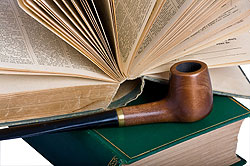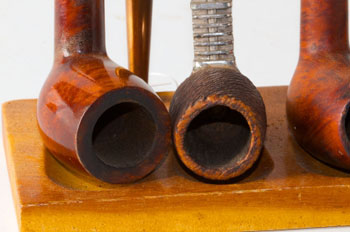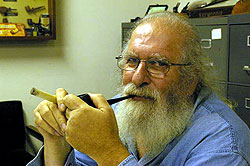Dr. Michael Garr, Ph. D. aka "Doc Garr"
 In his classic study, The Elementary Forms of the Religious Life, Emile Durkheim proposes a distinction between two types of objects—sacred and profane. Beliefs and behaviors that set apart the sacred from the profane is the realm of rituals. In our more secular society, the distinction between sacred and profane is still with us but in less dramatic fashion than we find in religion. Pipes can be thought of as sacred objects and pipe smoking as ritualistic activity.
In his classic study, The Elementary Forms of the Religious Life, Emile Durkheim proposes a distinction between two types of objects—sacred and profane. Beliefs and behaviors that set apart the sacred from the profane is the realm of rituals. In our more secular society, the distinction between sacred and profane is still with us but in less dramatic fashion than we find in religion. Pipes can be thought of as sacred objects and pipe smoking as ritualistic activity.
To understand this it will be useful to make a distinction also between the instrumental use of pipes and the ritualistic use of pipes. All behaviors can be seen as existing along a continuum between instrumental behaviors and ritualistic behavior, most having a mixture of the two. Instrumental behaviors are rational. They find efficient means to obtain desired ends. Thus all smoking is in some way instrumental. Cigarettes, cigars and pipes are delivery systems of tobacco into a smokable form. But, beyond the instrumental lies the ritualistic.
Ritualistic behavior seeks to provide feeling states that accompany the instrumental to produce feeling states, usually positive feelings like pleasure and/or relaxation. Pipe smokers can attest that smoking the pipe produces feelings of contemplation and relaxation and other pleasurable feelings where our world becomes orderly for however brief a time. The same is true for cigarettes, except the feeling states are shorter lived since smoking a cigarette is only a five to seven minute ritual compared to the one to two or more hours of pipe smoking. Cigar smoking is more ritualistic than cigarettes, but less so than pipe smoking.
Cigarette smokers use their nicotine delivery devices for relaxation, whether it is during a break, after a meal or after sex. And yet nicotine is a stimulant. It is the ritualistic use of cigarettes that results not in stimulation, but in relaxation.
Pipes as sacred objects
Many of us treat our pipes as revered objects that deserve special treatment. As a result, we use rituals to give our pipes their proper respect. For example, every time someone knocks a pipe on a hard object, I cringe. We display our pipes with pride. We polish our pipes with loving care. In short, we care for our pipes as sacred objects not to be just tossed around. We show them respect.
We engage in cleansing rituals to keep our pipes free of polluting elements and to ensure a well-maintained pipe. Clearly part of this is instrumental. But true instrumentalists do not clean their pipes. They allow cake and char to build up on the pipe. Many of us have a "knock-around" pipe that we don’t necessarily take good care of. This pipe is used instrumentally. Instrumentalists cannot understand why people would pay more than $100, even less, on a pipe. Why care about grain or a blast?
 We can see the same sort of thing among pipe collectors. Many collectors will not smoke their collectable pipes. On the one hand, instrumentally, smoking the pipe will decrease its monetary value. On the other hand, ritualistically, smoking the pipe will detract from the pipe as a work of art. As a result, some of us have pipes that once bought we do not smoke. For example, two years ago at the Chicago pipe show, I bought an unsmoked Walt Cannoy wax drip, I still have not smoked it. It is the only pipe in my collection still unsmoked. I am having trouble using it instrumentally and I am not planning on selling it. So why won’t I smoke it (I will eventually I hope)?
We can see the same sort of thing among pipe collectors. Many collectors will not smoke their collectable pipes. On the one hand, instrumentally, smoking the pipe will decrease its monetary value. On the other hand, ritualistically, smoking the pipe will detract from the pipe as a work of art. As a result, some of us have pipes that once bought we do not smoke. For example, two years ago at the Chicago pipe show, I bought an unsmoked Walt Cannoy wax drip, I still have not smoked it. It is the only pipe in my collection still unsmoked. I am having trouble using it instrumentally and I am not planning on selling it. So why won’t I smoke it (I will eventually I hope)?
Different churches or religious denominations divide the sacred from the profane differently. The same is true for the pipe world. It has not developed a universal consensus of beliefs and activities of all things pipe. Rather, there is diversity in belief and activity. The above-mentioned collector will not smoke a pipe for fear of desecrating it. Some suggest that the only true smoke of a pipe is its first smoke. Others believe that a pipe will smoke well only after it has been properly broken in. These beliefs are not individualistic; they are shared beliefs among those participating in the pipe world.
Smoking as ritualistic activity
We may think of rituals as institutionalized ways of behaving. That is to say, rituals are not performed by disconnected individuals in individualized ways; rituals are shared ways of acting. Rituals are repeated and repeatable social behaviors. They establish the proper way of doing something. Habits are routinized behaviors of individuals. Rituals are collective ways of doing something. As a result rituals have to be learned usually in a group setting. (With the advent of the internet a direct relationship to a group is no longer necessary, although it still is an indirect relationship.)
Take for example the packing of the pipe. There are different methods for the proper packing that is not too tight or too loose, but is just right. Many of us learn "the thirds" method of packing a pipe. We did not need to discover it on our own. Eventually, once the correct feel of a properly packed pipe is realized, we may fill our pipes with the right amount of tobacco.
How often did someone teach us about the "faux light"? Who thought of first charring the tobacco before having the proper light of the tobacco? How did this knowledge become established in the lore of pipe smoking and how does it get carried down from generation to generation of pipe smokers?
What do you use to light the pipe? We know that torches are discouraged, even though there are safe ways to use a torch. The old-time rockabilly musician Jerry Lee Lewis smokes expensive Dunhills and lights them with a torch charring the bowl rims terribly. Most of us will not do this for fear of damaging our revered object. But others argue that soft flames are still too hot and will scorch the rim as well. They advocate only the use of matches. All of these are shared methods of lighting a pipe.
Once the pipe is lit, then there is the proper method of actually smoking it. Consider when many cigar smokers start to smoke a pipe. They often smoke the pipe too quickly making the pipe too hot to hold and perhaps burning it out. Others worry about lighting a pipe too often to keep it going.
 After we are finished smoking the pipe, we then need to show proper respect of the pipe by cleaning it properly. We remove the dottle rather than leaving it inside the pipe. We use pipe cleaners to remove what moisture and other bits that remain in the stem and shank. We may let our pipes rest or put them in their place on our rotation of pipes. Instrumentalists tend not to clean their pipes. I had an instrumentalist friend who would never clean his inexpensive pipes. Once they became too caked, he would just buy another inexpensive pipe.
After we are finished smoking the pipe, we then need to show proper respect of the pipe by cleaning it properly. We remove the dottle rather than leaving it inside the pipe. We use pipe cleaners to remove what moisture and other bits that remain in the stem and shank. We may let our pipes rest or put them in their place on our rotation of pipes. Instrumentalists tend not to clean their pipes. I had an instrumentalist friend who would never clean his inexpensive pipes. Once they became too caked, he would just buy another inexpensive pipe.
All of these activities related to smoking a pipe are learned. They are collective solutions to how to smoke that gets transmitted to new generations of pipe smokers. And while they may have instrumental reasons behind them, we do these activities routinely, many times without thinking about the instrumental reasons behind them. We do these as ritual activities.
While we may smoke our pipes alone, we also often find ourselves seeking out other like-minded people who also smoke a pipe. Like the ritual of sharing in a toast or sharing a meal, we often share smoking our pipes with other pipes smokers. We create a sense of conviviality between us. We speak of a brotherhood of briar. We form pipe clubs. In these group settings we learn new ritual beliefs and activities and we repeat those we have already learned.
Of course, much of the content of the forums on PipesMagazine.com are full of information regarding the proper methods of smoking. Some of these ideas are novel, not yet institutionalized, not yet shared, not yet ritualistic. Other ideas and practices are well-honed, the stuff of rituals. And whether novel or well-honed, they all have on thing in common—the reverie that we show to our pipes as the sacred objects they are.

"Doc" is currently president of The United Pipe Clubs of America and Pocono Intermountain Pipe Enthusiasts. In 2011 Doc won the national slow-smoke championship in Chicago and competed in the World Cup in Eindhoven, Netherlands, where he came in 69th out of 338 smokers. He has been a pipe smoker for almost 25 years. When he is not smoking a pipe, Doc is Professor of Sociology at Wilkes University. He also moonlights at El Humidor, Wilkes-Barre, PA, a tobacco store. |

















Very nice read.
Very cool article!!
I used to tap my pipe ash out of the bowl on ashtray and such just to watch a fellow briar bro ( Dunhill afficiando) cringe and chastise me. He also went nutz when I would smoke in the car with window down (cooling wind on pipe would cause bowl to crack).
My wife noticed my enjoyment of the ritual part of pipe smoking befor I even thought about it.
I can’t decide if I’m a ritualistic nstrumentalist or an nstrumentalistic ritualist.
My smoking process, by definition, is a habit. My cleaning process, on the other hand, is much more ritualistic. Especially the virgin sacrifice… lol. This is a very good article, with a lot of food for thought.
Good write. I found myself laughing. If one is to put a tag on “my style”, it would be “Almost all the above”. I hardly ever pack my pipe the same because all my pipes and leaf smoke differently. However all my pipes are well enjoyed and it shows. My pipes do have the rim charred a bit. I believe that this is badge of honor. Although I have used a torch on some and others I don’t, they all have this badge. I guess what it all boils down to is that I enjoy smoking a pipe. That is all that really matters, isn’t it?
Great article Doc! Interesting and thought provoking look from the human nature point of view.
Kudos for courageously venturing into the murky area where it becomes difficult to distinguish habit from ritual — especially when speaking colloquially. To me, smoking is all about ceremony, but then again I am notoriously anal retentive.
.
If one uses a different wine glass shape for different wines is that ritualistic, or instrumental? If one dedicates different pipes to different blends, etc…
A pipe just HAS to be smoked to be properly appreciated; sorry to have to disagree on anyone on that, but there it is. I guess that makes me an instrumentalist. I’ve never spent more than $45 on a pipe either- but then I used to get great discounts when I sold pipes retail. Still, I’d not be spending much more than $100 on a pipe even if I could afford it.
I’ve got some scorch marks too, but I’d never dream of using a torch because I cannot understand why anyone would risk damaging a functional or even very attractive pipe. Neither do I believe in pipes only for Latakia or Virginia, although I can see how certain shapes are better suited for certain tobaccos. I just don’t get that high anality factor.
Another thing, I tend to keep my pipes on the clean side, but one of my best smokes was Sweet Oriental thru a gurgling Peterson Army last winter
I,after reading this article must label myself as habitually and instrumentally ritualistic! Been smoking pipes for over 40 yrs and have come to realize that choosing, filling, lighting and smoking the pipe takes about as much care as cleaning a pipe after its use after it cools down. I guess it’s as much respect for an instrument tht will provide me with pleasure and comfort as a habit of mine after all these years. I mean, cleaning a pipe after a smoke is just what gpoes with it in my opinion. Let me tell you as a youngbuck in my late teens ans early 20’s I have had some really rancid smokes as a result of not caring for my pipes. Looks like my Dad gets kudos for that. I had often seen him watching TV ans cleaning a few pipes while doing it. So, growing up seeing this it seemed to be the thing to do! And, I’m am Truly grateful that I had his silent mentorship as he wasn’t one to say much about pipe smoking except that one Christmas he handed me a pkg which contained two pouches of Prince Albert and a Grabow and said ,”boy if you’re gonna smoke ya ought to smoke this”. From there I followed his lead. Choose, fill, light, smoke clean and rest it. Ritual, instrumental, habit? Who the heck knows; I’m just Lovin’ It!
It’s very easy to see the overlap of being both a ritualistic and instrumental pipe smoker. I never thought about it until I read your article. Thanks for bringing it to light, Doc!
Excellent last read on pipes for the evening. Will
help to sooth me to a good night’s rest on a cold
and snowy night.
Thanks for writing it.